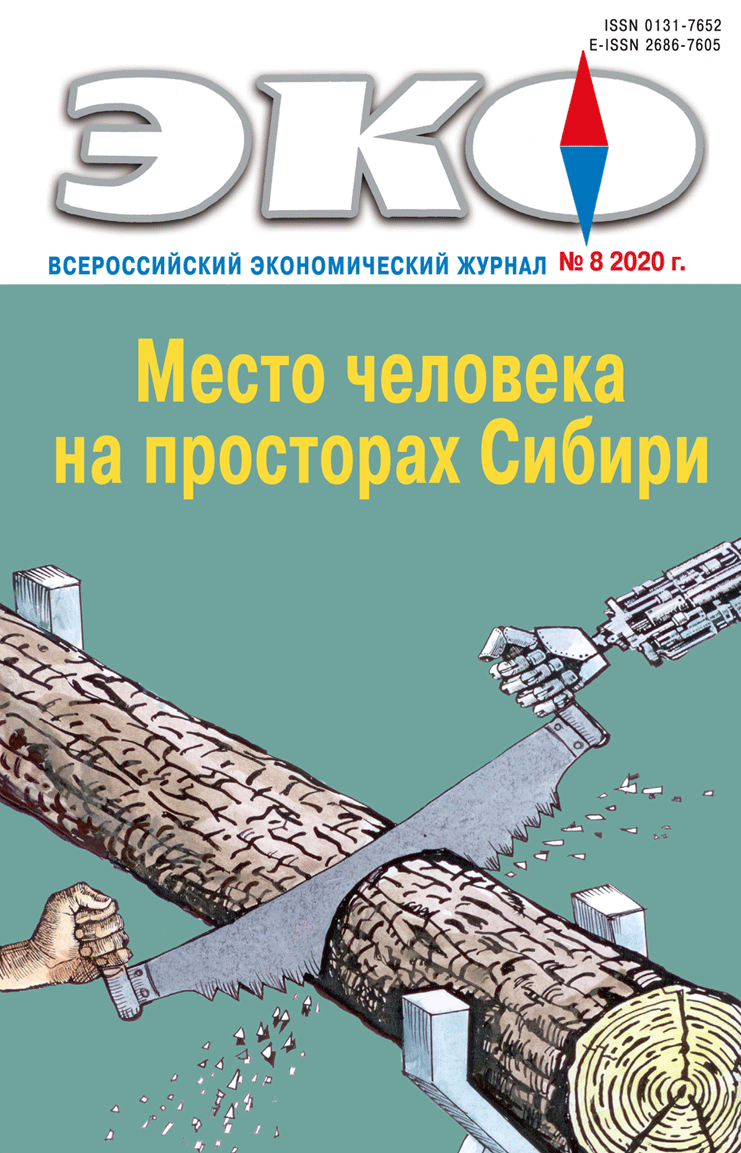Тема номера: Место человека на просторах Сибири
Published 2020-08-08
Keywords
- depopulation,
- demographic potential,
- age structure,
- population ageing,
- fertility
- population reproduction,
- spatial development ...More
How to Cite
1.
Soboleva С, Smirnova Н, Chudaeva О. Demographic Problems of Siberia in the Context of Spatial Development. ECO [Internet]. 2020 Aug. 8 [cited 2026 Jan. 17];50(8):48-65. Available from: https://ecotrends.ru/index.php/eco/article/view/4089
Abstract
The paper describes current demographic problems of Siberia in the context of spatial development and assesses their consequences for the future of the country. Using Rosstat data, the authors demonstrate that against the background of general reduction of population of the Siberian Federal district, especially rural, there was a reduction in the number and share of people younger than working age, a reduction of working age population, and at an accelerated rate compared to Russia as a whole, the increase in the number and share of old age pensioners. Thus, as a result of a long period of low birth rate, the population is aging. A progressive age structure at the beginning of the period under study has become regressive, and this process will increase in the future, if decisive measures are not taken. Discussing the idea of the need for Russia to support the growth of agglomerations, promoted in recent years, it is emphasized that unlike large cities, which for a long time have not reproduced themselves and have been growing only due to an influx of population from outside, a natural source of demographic growth for the country – villages and small towns. In addition to its demographic importance, the basic network of settlements in the extensive territory of the country and along the long borders is of paramount geopolitical importance, ensuring the connectivity of space and control over it. This is especially true of the vast territories of Siberia and the Far East. According to the authors, Russia’s strategic development plans should pay maximum attention to villages and small towns, since measures aimed at improving the socio-economic sphere and increasing the birth rate will have their most effective and rapid impact here, as well as contributing to spatial development and consolidation of population in strategically important territories.References
- Пациорковский В. В. Сельско-городская Россия. М.: ИСЭПН РАН. 2010а. 390 с.
- Пациорковский В. В. Факторы демографического развития: пространственное размещение населения // Народонаселение. 2010б. № 4. С. 35–50.
- Пациорковский В. В. Изменение условий жизни и размещения населения – ключевые факторы демографического развития // Народонаселение. 2012. № 2. С. 35–40.
- Сафарова Г. Старение городского и сельского населения России // Современные проблемы старения населения в мире: тенденции, перспективы, взаимоотношения между поколениями. М.: МАКС Пресс, 2004. С. 121–130.
- Сафарова Г., Косолапенко Н., Арутюнов В. Региональная дифференциация показателей старения населения России // Успехи геронтологии. 2005. Вып. 16. C. 7–13.
- Смирнов В. М., Попков С. Ю. Социально-экономические аспекты демографической ситуации в России: долгосрочные последствия сокращения численности работоспособного населения // Национальные интересы: приоритеты и безопасность. 2009. № 16. С. 54–58.
- Соболева С. В., Смирнова Н. Е., Чудаева О. В. Заболеваемость населения Сибири в контексте российских тенденций // Гуманитарные науки в Сибири. 2018. № 1. С. 71–80.
- Соболева С. В., Смирнова Н. Е., Чудаева О. В. Изменения численности и половозрастной структуры населения Сибирского федерального округа и его регионов в 1989–2017 гг.: оценка последствий и риски // Регион: экономика и социология. 2019. № 2. С. 151–184.
- Тагаева Т. О., Казанцева Л. К. Состояние здоровья российского населения и влияющие на него факторы // Формирование и использование человеческого капитала в современной экономике: монография / колл. авторов; под ред. Г. П. Литвинцевой; М-во науки и высш. обр. РФ, Новосиб. гос. тех. ун-т, ИЭОПП СО РАН. Новосибирск: Изд-во НГТУ, 2018. Гл. 3.3. С. 141–170.
- Яковлев Е. Как материнский капитал повлиял на рождаемость. URL: https://www.vedomosti.ru/opinion/articles/2020/02/27/823925-materinskii-kapital (дата обращения: 24.06.2020).

